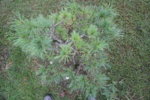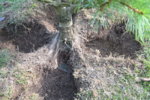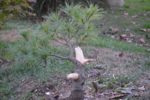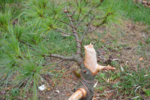October 13th Trunk chop
I've been really busy the last couple months beginning with the primaries in the Fall
then family, work and the Christmas rush/work. Been trying to get a day off since Nov.1
but we are so short handed because folks don't want to work, my leave just continues
to be denied. My wife really wanted to visit the Biltmore for her birthday/Christmastime...
That said, I've failed to post up any of the progress of my dwarf EWP since.
With the gracious help and insight of
@0soyoung I went against my "religious beliefs"
and did a trunk chop

Actually as difficult as it was to persuade me to do so, the task of convincing me to
do the trunk chop was easier, than it would have been, had the branches been kept
properly whilst growing in ground over the last decade.
Now, with such heavy branches in the top 1/3 of the tree, one of which crossed the trunk
badly the decision was based on "it can't hurt any more than it does already" so if it
increases its' potential, let's do it.

So just below these forging tongs I believe they are, you can branch removed, how heavy a branch I'm talking about.
It went completely across the front of the tree. Impossible to bend/break back, and too
far out of proportion to do anything with at all. This may've been why I decided the trunk chop
wasn't a bad idea after all. Other than that, there were fairly good opportunities for great
branch placement all the way up for an informal upright.

The trunk here was surprisingly difficult to snap off. I had to undercut it a good deal to break it off.
I knew I was going lower, but wanted to practice here 1st to see how the tree worked with what I had.


Not what I was shooting for and I think I undercut at the wrong or opposite angle, still not a good
representation of the desired outcome for the final chop, but gained some familiarity with the wood.
I think I had to undercut too much to get the broken effect I was shooting for too. 1st timer.
More to come.

























